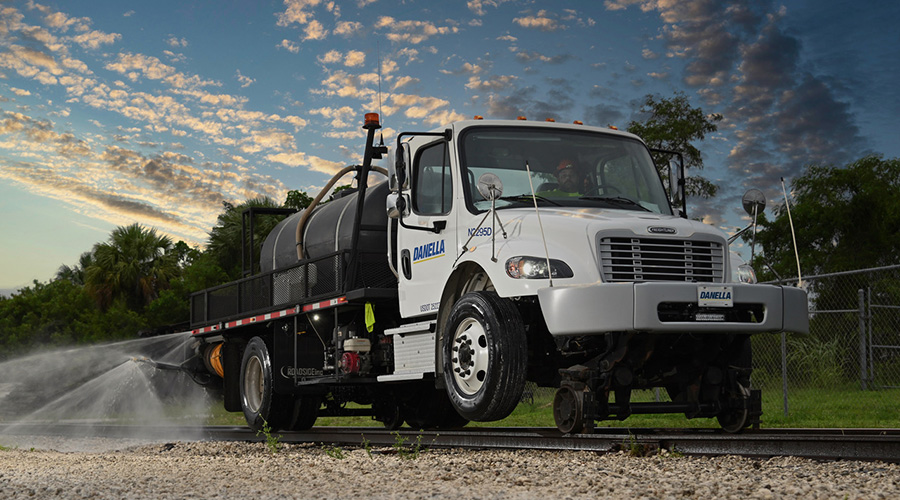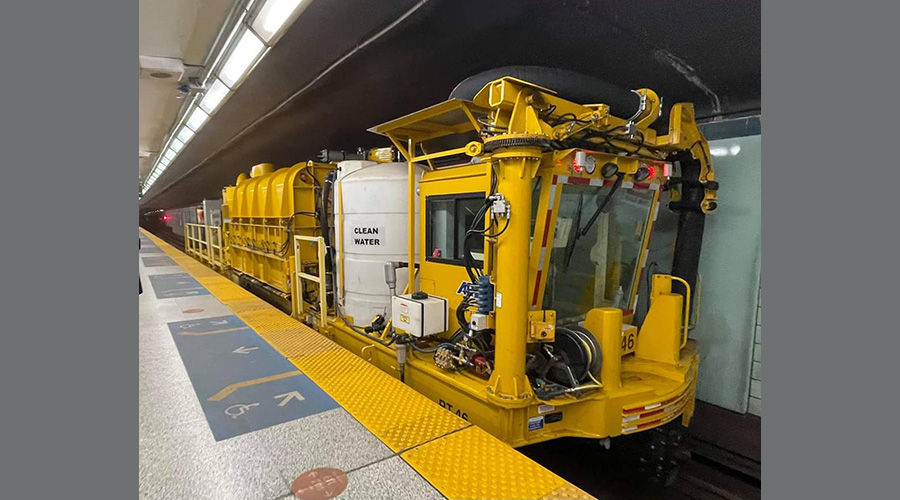Stay updated on news, articles and information for the rail industry
May 2016
Rail News: MOW
Rail product update: snow plows, hot- and cold-air blowers, rail heating systems, idle-reduction technology
Spring is the best time to prepare for the ice and snow and cold to come. In this "winter challenges" product roundup, eight companies share details on a range of solutions to help railroads beat back whatever winter dishes out — from heavy-duty snow plows and blowers to automated rail heating systems to idle-reduction technology.
Harsco Rail
The Spreader Ditcher can be used to plow heavy snow, spread ballast, reshape cuts in banks and cut trackside ditches. Weighing 160,000 to 170,000 pounds (depending on specifications for operational, ride and travel stability), it is equipped with an operator control cab, front plow, side wings, two non-powered bogies, AAR couplers and an auxiliary power unit (APU) for electrical/hydraulic power.
The Spreader Ditcher High Plow can clear 16-foot snow drifts and widen snow cuts with main wings and bank slopers, and can “rip solid blue ice and handle slides mixed with rock, stumps and frozen matter,” Harsco Rail officials said. The machine also cuts snow ditches for thaws and spreads snow in classification and switch yards.
New features include an enclosed rear walkway to double as a work area and enable access off the machine during heavy snow fighting operations. The cab layout is larger and offers seating for five. Meanwhile, heating and AC have been increased, and improved lighting has been added throughout the machine.
Other features include a desktop locomotive control option through the 27-pin connector, in-cab travel lock control of the front plow and side wings, powered front cross plow control options, and proportion snow control to optimize plow height over crossings and switches. The Spreader Ditcher also features a fuel-efficient 110-horsepower turbo diesel.
Knox Kershaw Inc.
Knox Kershaw Inc.’s KSF 940 Snow Fighter is designed to combat heavy snow in freezing temperatures. With a 50,000-pound working weight, it offers a spacious, pressurized cab featuring a second operator’s seat and joystick controls; and specially designed wings, plow and broom built for moving heavy snow in harsh environments.
The cab’s “unique window placement” provides “unsurpassed operator visibility,” company officials said. The tilt-cab feature enables access to major components, and the side-mounted heater and AC provide a clean roof line with no maintenance components on the roof.
The four-season plow features a heavy structural frame that can be used for snow or ballast. The bolt-on curl kits allow for plowing through deep snow. High capacity, 36-inch snow wings clear snow 16 feet from the track center. The broom and auger motor are series driven with individual drives allowing the snow switch cleaner to blow snow over 20 feet to either side.
The power unit comes equipped with a 260-horsepower Cummins engine, Espar diesel-fired engine block heater and Arctic Fox hydraulic tank heater. Dual 8-D batteries offer cranking power for cold weather starts.
The KSF 940 is a snow fighter that can be converted into a ballast regulator and a brush cutter for year-round use.
Phoenix Contact USA/Kapsch TrafficCom USA Inc.
Phoenix Contact USA and Kapsch TrafficCom USA Inc. developed an automated rail heating system designed to help transit-rail agencies reduce energy costs. The wireless supervisory control and data acquisition (SCADA) network system is powered by Kapsch’s DYNAC software and employs a variety of Phoenix Contact control components.
Heaters located along the electrified third rail and on wayside equipment prevent build-up of ice and snow during inclement weather.
“Traditionally, rail transit agency employees manually turn the rail heaters on during the fall and turn them off again in the spring,” company officials said. “This manual process had high labor costs and was also a major safety issue.”
The automated system can be installed without disrupting service. Operators monitor and control the individual heat traces from a central location; by touching a screen, they can turn the heaters on or off depending on weather conditions.
Kapsch’s DYNAC SCADA, along with Phoenix Contact’s control software, enables operators to remotely perform routine system diagnostics collection to ensure the heaters can be controlled at any time, all from a single HMI interface at each server. The interface panels along the rail serve as the primary link between the DYNAC SCADA master and a network of control point nodes throughout the network of Phoenix Contact 900 MHz radios. Each node controls, collects and holds data for SCADA commands.
Power Drives Inc.
Power Drives Inc. developed and engineered PowerHouse, an idle-reduction technology designed to enable a locomotive to shut down “in the coldest temperatures,” company officials said. It features a 136,500 BTU/hour (40kW) diesel-fired heat exchanger, which provides rapid heating and dependability.
Compliant with EPA Tier 4 emission standards and EPA SmartWay certified, the PowerHouse is available in two design models. Used when locomotives have ready access to 120V (5 amps) shore power, the PowerHouse 120 model is “the only 120 volt plug-in offered in the rail industry,” company officials said. The diesel-powered APU model is a modular, two-piece APU, providing installation flexibility, and is ideal for road haul and run-through locomotives. The APU also includes standard remote monitoring for access to real-time operating data. Both models are compact and easy to install on any locomotive, company officials said.
In addition, both PowerHouse models include microprocessor controls to automatically start and stop the heat exchanger to avoid continuous run time, further reducing fuel consumption, emissions and noise.
R.P.M. Tech Inc.
R.P.M. Tech Inc. offers the AF1 cold-air blower. On the market for the past 25 years, the AF1 is used by a variety of North American railroads. With 525 mph (850 km/h) wind velocity and 19,500 cubic feet per minute, it clears switches and rails of ice, snow, sand and debris.
Installed in the rear of a Peterbilt 320, the AF1 unit enables users to drive from one location to another, and clean and prepare different rail yards with a single-person operation. “This flexibility helps save time, and reduces costs by increasing production efficiency in snow removal and maintenance work,” company officials said.
The blower is powered by a 440-horsepower (328 kW) turbocharged diesel engine and the air flow is provided by a two-stage centrifugal fan system. Via joystick, the operations are controlled hydraulically for the rotation, telescopic and lateral movement. The nozzle descends as low as three inches from the rail and as high as 39 inches. It reaches as far as three feet from each end of the vehicle and rotates at 180 degrees.
Railway Equipment Co.
Railway Equipment Co. offers an array of products designed to help railroads meet “the many stresses and challenges of winter,” as company officials put it. The product line includes natural gas, propane and electric hot air blowers that are stand-alone or housed inside steel bungalows.
The company also provides electric controllers with round and flat rods, which keep the switches clear of ice and snow. Fiberglass switch covers allow dragging and blowing snow to be kept away from the switch, as well. Heat is retained from the blowers under the covers, ensuring that switches will not freeze.
The Sno-Net® remote monitoring package can be added to new heaters and retrofitted into older models to view and control the heaters from a laptop. This reduces manpower costs and increases switch reliability, company officials said. Railroads can receive notifications when heaters should or should not be running via the Sno-Net monitoring system, which reduces power consumption.
The company’s newest product is a combination switch machine, battery cell and voltage monitoring device. It predicts switch and battery cell failures, thus improving the reliability of the switch systems. It also can detect when ice or snow is impeding proper switch function.
Rail-Net® also can be added to the monitors to assess winter conditions of the switch from a desk or vehicle.
Sealeze, a Jason company
SnowProtec® is a brush-based, patented system developed to protect turnouts against falling and drifting snow while making switch-heaters more effective. Passive in operation, it has “proven effective” for more than 12 years in more than 1,600 installations, company officials said.
In addition to reducing the impacts of winter weather on operations, new wind tunnel and field testing has confirmed SnowProtec as a barrier to stop drifting sand from impacting switch function, company officials said.
The company also is “dedicated to bringing new perspectives and ideas” and wants to “collaborate” with customers: Spectrum can provide custom solutions to meet track switch heater and controller needs, officials said.
Spectrum Inc.
Railroads need to keep their switches functioning in cold temperatures, and officials at Spectrum Inc. say they have adapted the way they do business to meet the railroad industry’s needs. The company stocks flat jacket cal rod heaters and crib heaters in standard lengths in both 240V and 480V so that customers can “get track switch heaters in as fast as 24 hours,” company officials said.
Founded in 1965, Spectrum uses commercial off-the-shelf components in its hot air blowers and control cabinets to reduce long-term maintenance costs and down time, company officials said. “No other electric hot-air blower has been on the North American switch heater market longer than ours,” they added.
Email comments or questions to prograil@tradepress.com.


 LRW Honors Amtrak’s Acheson As Railway Woman Of The Year
LRW Honors Amtrak’s Acheson As Railway Woman Of The Year
 From Editor-In-Chief Foran: Of Gender Equity And Inclusion
From Editor-In-Chief Foran: Of Gender Equity And Inclusion
 Spotlight On Some Of Today’s Rail Safety Products
Spotlight On Some Of Today’s Rail Safety Products
 Women of Influence in Rail eBook
Women of Influence in Rail eBook
 railPrime
railPrime







